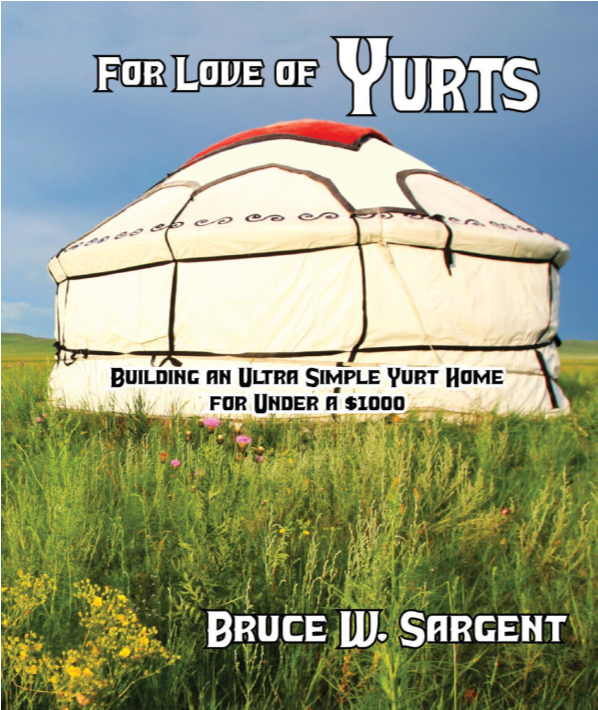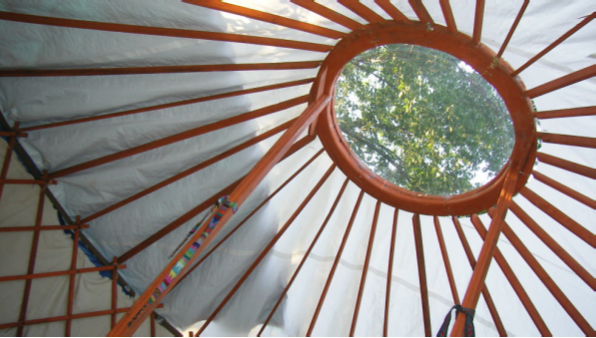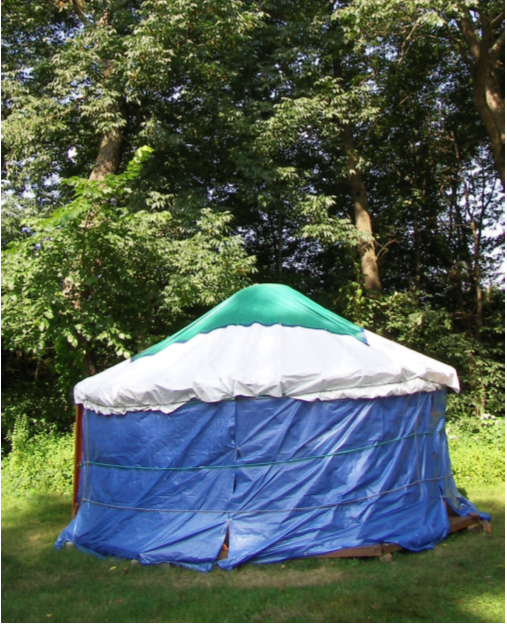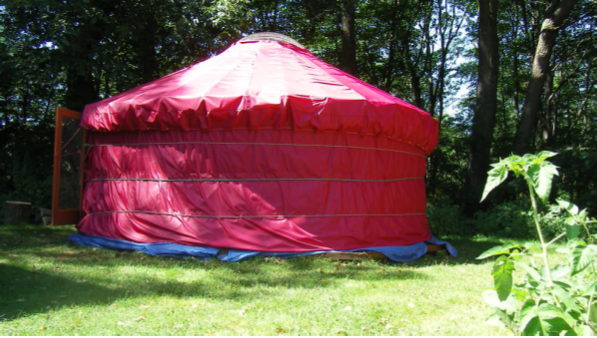Bruce Sargent wrote me a while back about a yurt he had built and that he was in the process of putting a book together to tell his story and show others how he built a yurt for less than $1,000.
Here is what Bruce has to say about his book: For yurt lovers everywhere, we’ve created the newest and best book about making an ultra simple, hand-made, yurt-home.

Ten years ago, at Spirit Hollow, a shamanic school tucked back in the Taconic Mountains of Vermont, I fell in love with yurts. I was bedazzled by an exotic tent, with a framed door, wooden floor, diamond latticed walls and rays of rafters, arching out from a central sky light. I was dumbstruck by the complex beauty and warmth of a tent in Green Mountain winter.

Later as I worked in Boston, seventy hours per week, at a Fortune 500 company, making more money than I had at any point in my life, I daydreamed of yurts. I sketched yurts set beside a roaring brook, in Arlington, in Vermont’s Kelly Stand. I made calculations of the cost of acreage, cost of a bridge to cross the river, cost of a floor and the cost of a Pacific Yurt sixteen feet in diameter. I would calculate the month of next year that I could afford to actualize my dreams.
In the next year, down-sized by life, aching for simplicity, living in an attic room and tending an organic garden belonging to friends, my head was still full of yurts. Purchasing land and a Pacific Yurt was now out of the question. I obtained books by Len Charney, Paul King and Dan Kuehn and down loaded a paper by Charles Lokey, works that would comprise the books of my yurt bible. I studied with religious fervor. Could I build a yurt, bit by bit, over the next several years?

How hard could it to build a yurt? Could I drill six holes in an eight foot stick? Could I drill six holes in sixty-six, eight foot sticks? Could I tie a knot at two ends of a cord after threading the cord through holes that I drilled? I knew I could do all of this and build a yurt wall, and from this place, I believed I could take on the rest of it. But could I really?

“A year and a half to complete everything”, I thought, but could I design and construct something that would fit and hold together, would actually work? To my amazement and joy, within two months, I moved into a new sixteen foot diameter yurt, my “ger” (Mongolian for “home”) all at a cost of less than $1000 or about one tenth of t he cost of a Pacific Yurt. Baku, a Japanese friend of mine said, “It wasn’t that God helped you build a yurt. It’s more like you helped God build it.”

How this all happen, step by step, the ideas, the calculations, designs, construction ideas that led to the simplest plan possible, the good fortune and blind luck that completed my yurt -home is the story that follows. Check out his book and website at For Love Of Yurts.


As much as a I love the modern designs and rustic cabins, I hold an immense appreciation for posts like this one. In this economic climate, it makes perfect sense!
There are good companies that offer wonderful products but nothing, I mean nothing beats the DIYers!
People like Lamar of Solar Home, Bruce Sargent, Peter King and quirky folks at the Dancing Rabbit Commune make it possible for aspiring Tiny Home owners to realize their dreams without sacrificing their financial stability.
Keep up the good work!
Personally, I would love to see a post on varying methods of building a Tiny House complete with cost analysis on such areas as Sand Bags, Yurts, Geodesic Domes, Cabin with reclaimed material, Straw Bale, Shipping Containers, etc.
Hi Epperson – I’ll do my best to cover your suggestions above. I depend on others to share their experiences so can’t make any promises. I also try to cover the full range of possibilities out there, which includes those with money and those without and everything in between. I think you will like tomorrows post so stay tuned…Kent
How far along are you in your quest to build a Timber Framed Log Cabin?
Congrats, Bruce – and good luck with your book!
Interesting! He’s a Sargent though, not sure I know him. I live and work in Mongolia, (that’s outer Mongolia) The Mongolian word is Ger pronounced Gar like Gary just no y sound. Its a wonderful, simple, cheap home! Its round so heating is good, they use coal here, sucks. Yucky smoke here in Ulaanbaatar the capital. Any questions please ask my wife is Mongolian too,
I agree, the design and materials used in Gers/Yurts are very simple and affordable. Despite some modifications for insulation, I just don’t understand why some of the larger Yurt companies here charge such a high fee.
“I just don’t understand why some of the larger Yurt companies here charge such a high fee.” They do it because they can! Same with “tiny home” builders and with builders of “vardoes.” Ihave built 3 wagons, none cost over $1200 excluding (free) frames, wheels and tires. Theyn werenall recycled from trailers I demolished (paid). My last tiny house (shell) is 80 sq ft with a140 sq ft deck. Deck has a 4X6 ft covered bathroom tucked in the corner. Built, including pier blocks etc…..$1022!!
Hi David:
I have about 1000 questions. So let’s do number one to start: Are there still people in Mongolia who are making gers the old way and how could I be in contact with them? Two: Are there classic Mongolian measurements in making a ger, like Inuit measures of a kayak which is done in forearms? We can have the conversation here and at forloveofyurt@gmail.com I use the word “yurt” to communicate. When I use “ger” many people don’t know what I am talking about. I sometimes use “yurt-home” and also try to teach “ger” when I can. So 998 to go. How many do you think you would be OK with?
Thanks.
Bruce W Sargent
Can you bypass the building codes this way? Would it legally be considered a tent, thereby a temporary structure? That alone would save a huge sum.
Hi Beth,
The yurt I built worked in Massachusetts and Vermont but for different reasons. Because the structure did not require digging into the ground, it was considered temporary shelter (a tent) in Massachusetts. If I had built a permanent floor in Massachusetts it would have been subject to building codes. In Vermont, one can construct a primitive shelter on land and stay for 60 days out of year in it. The shelter can be quite simple or quite elaborate. Yurts, with permission of a town board, could be considered a primitive shelter, an entirely different permission than in Massachusetts.
Bruce Sargent